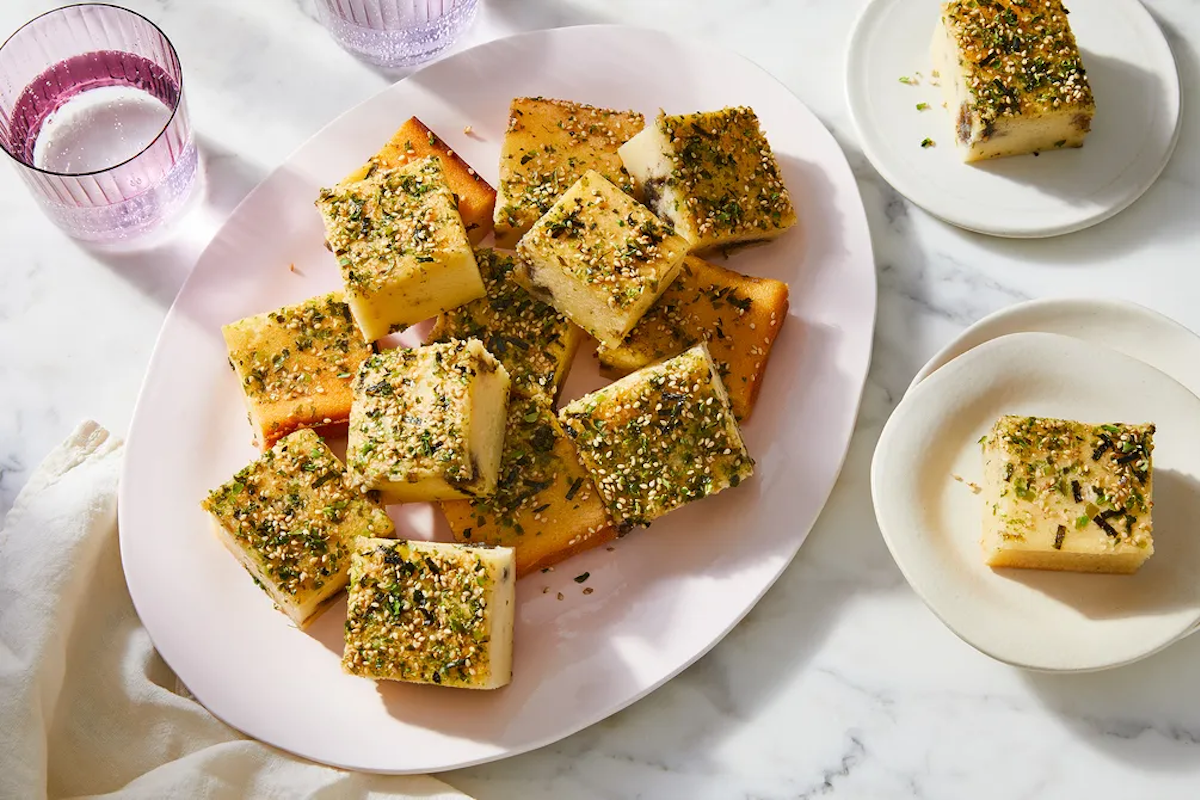Daphne Kauahi'ilani Jenkins measures time in butter mochi. Each Friday in Portland, Oregon, she sells tray after tray of rotating flavors, offering slices like Passion Fruit–Dark Chocolate, Macadamia–Key Lime Pie, and Matcha-Hibiscus-Strawberry for $5 a piece. Jenkins, a holistic nutritionist and home baker, describes them as "delicious, and beautiful in a very homey way." (I'd offer one edit, which is that her butter mochi — adorned with rose petals, mango-peach preserves, and delicate slivers of dried lemon — in fact looks incredibly professional.)
There's nothing in the American baking lexicon that's truly comparable to butter mochi, the classic Hawaiian tray bake. At first glance, butter mochi brings to mind an American blondie — indeed they are both square, chewy, and pale buttery-gold in color. Upon his first bite of a dense, custardy interior slice, my dad proclaimed it "chess pie, but with coconut milk," which feels far more apt. Jenkins is more likely to compare it to another Southern favorite: "It's this viscous, elastic, but pound-cake-esque baked good," she said. "Because it's so chewy, it delivers flavor over and over and over. It kind of has its way with you."
Butter mochi recipes begin with glutinous rice flour, also known as sweet rice flour or mochiko, and usually end shortly thereafter. At its most dressed-down — the way it's usually made — butter mochi is glutinous rice flour, butter, eggs, coconut and dairy milk, and sugar. It's decadent but simple to put together. Glutinous rice flour imparts butter mochi's signature chewy-bouncy "Q" texture, also found in boba, bibingka, daifuku, and rice cakes.
In part, Jenkins uses her weekly mochi drops to reject nutrition's myopia — she frequently incorporates heavily processed ingredients in her butter mochi, an intentional protest against diet culture's tendency to characterize certain foods as "bad" for you. "I started turning to my pantry, and was really glad I didn't listen to the spooky nutrition stuff that I learned while getting my nutrition master's degree, where people were really coming down hard on processed food," she said. "Processed food kept my people alive during World War II." Shelf-stable products like canned guava concentrate, liliko'i (aka passion fruit) jelly, canned pineapple and lychee, and arare are central flavors in her weekly menus.
In Hawaii, between 85 and 90 percent of food is imported. In addition to being one of the most densely militarized regions on the planet, it boasts the highest cost of living compared to any other state — which means grocery bills are higher, too. Imported canned goods (like Spam, which Hawaii residents consume almost 7 million cans of per year) are some of the more affordable options available. Hawaii's verdant, fertile land would be capable of feeding the people who live there, were it not for the fact that so much of it is occupied by the military, the tourism industry, and monocrop agriculture. For myriad reasons, shelf-stable ingredients have become an integral part of Hawaii's culinary landscape. Diet culture, which tends to cater to an assumed white, able-bodied, affluent audience, often neglects to consider how issues like food apartheid, land equity, and colonization might impact how people eat. In her nutrition program, "the recurrent theme was always: [eat] as close to the earth as possible," said Jenkins. "But until there's land back, I think it's really weird to ask everyone to do that."
* * *
The farther you are from the archipelago, the less likely you are to find butter mochi in a bakery display. Even on Oahu, where Jenkins grew up, its natural habitat is the home kitchen, where it's usually presented in a casserole dish. Sometimes you'd find it at a lunch spot, wrapped in cellophane and served alongside macaroni salad, two scoops of rice, and a protein. "I've seen butter mochi growing up — and here [in Portland] even — in those contexts of working people's food. Like affordable, decadent goodness," she said.
She'll often riff on nostalgic flavors, like the Hawaiian Hurricane Popcorn she grew up eating, toying with the idea that the butter mochi itself is a comestible link to childhood comfort. She treats grocery shopping "like getting art supplies," and waits patiently — sometimes until the night before baking — before inspiration hits. "It's this exercise in trusting my intuition. We could argue about which side of the brain that comes from," she said. "Maybe it's the heart."
In a previous life, well before her butter mochi epoch, Jenkins was a fifth-grade teacher in a public school. "I've definitely worked in a dynamic where I was fungible. It felt like I could be used up and then replaced," she said. Labor, and her experiences of feeling expendable, are hugely influential to how she approaches each Aloha Friday (Daphne's name for her weekly butter mochi project, and a nod to the Hawaiian tradition of celebrating each work week's end). Instead of deriving value from profit and scalability, it's about honoring her own labor, breaking "the fourth wall of Instagram" by sharing her baking rather than just posting it, and making just enough money to do it all over again next week. "It's allowing me to practice with alternative economies and how I can connect with my community," she said. This self-employment also allows her the freedom to experiment with questions like, "What is my worth? How much labor do I want to do this week?"
Every Thursday, Jenkins is figuring out what she'll be making and selling the next morning — maybe Guava-Coconut–Li Hing Mui or Tulsi-Mango–Dragon Fruit. Perhaps Black Sesame–Swirled Furikake Popcorn. Whatever the flavor, move fast on Friday, because by midday it'll be too late. Of course, there's always next week.




Shares